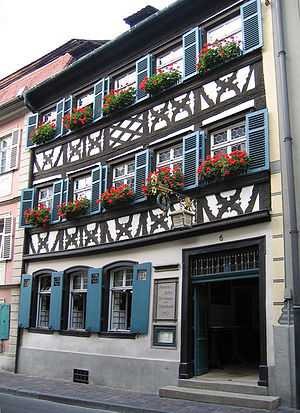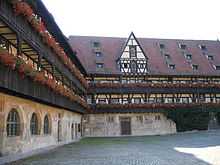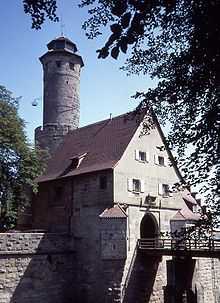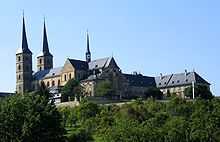Bamberg
| Bamberg | ||
|---|---|---|
 | ||
| ||
 Bamberg | ||
| Coordinates: 49°54′N 10°54′E / 49.900°N 10.900°ECoordinates: 49°54′N 10°54′E / 49.900°N 10.900°E | ||
| Country | Germany | |
| State | Bavaria | |
| Admin. region | Upper Franconia | |
| District | Urban districts of Germany | |
| Government | ||
| • Lord Mayor | Andreas Starke (SPD) | |
| Area | ||
| • Total | 54.58 km2 (21.07 sq mi) | |
| Elevation | 230 - 386 m (−1,036 ft) | |
| Population (2012-12-31)[1] | ||
| • Total | 70,863 | |
| • Density | 1,300/km2 (3,400/sq mi) | |
| Time zone | CET/CEST (UTC+1/+2) | |
| Postal codes | 96001–96052 | |
| Dialling codes | 0951 | |
| Vehicle registration | BA | |
| Website | www.stadt.bamberg.de | |
| Town of Bamberg | |
|---|---|
| Name as inscribed on the World Heritage List | |
 | |
| Type | Cultural |
| Criteria | ii, iv |
| Reference | 624 |
| UNESCO region | Europe and North America |
| Inscription history | |
| Inscription | 1993 (17th Session) |


Bamberg (German pronunciation: [ˈbambɛɐ̯k]) is a town in Bavaria, Germany, located in Upper Franconia on the river Regnitz close to its confluence with the river Main. Its historic city center is a listed UNESCO world heritage site.
History
During the post-Roman centuries of Germanic migration and settlement, the region afterwards included in the Diocese of Bamberg was inhabited for the most part by Slavs. The town, first mentioned in 902, grew up by the castle (Babenberch) which gave its name to the Babenberg family. On their extinction it passed to the Saxon house. The area was Christianized chiefly by the monks of the Benedictine Fulda Abbey, and the land was under the spiritual authority of the Diocese of Würzburg.
In 1007, Holy Roman Emperor Henry II made Bamberg a family inheritance, the seat of a separate diocese. The emperor's purpose in this was to make the Diocese of Würzburg less unwieldy in size and to give Christianity a firmer footing in the districts of Franconia, east of Bamberg. In 1008, after long negotiations with the Bishops of Würzburg and Eichstätt, who were to cede portions of their dioceses, the boundaries of the new diocese were defined, and Pope John XVIII granted the papal confirmation in the same year. Henry II ordered the building of a new cathedral, which was consecrated May 6, 1012. The church was enriched with gifts from the pope, and Henry II had it dedicated in honor of him. In 1017 Henry II also founded Michaelsberg Abbey on the Michaelsberg ("Mount St. Michael"), near Bamberg, a Benedictine abbey for the training of the clergy. The emperor and his wife Cunigunde gave large temporal possessions to the new diocese, and it received many privileges out of which grew the secular power of the bishop. Pope Benedict VIII during his visit to Bamberg (1020) placed the diocese in direct dependence on the Holy See. For a short time Bamberg was the centre of the Holy Roman Empire. Henry and Cunigunde were both buried in the cathedral.
From the middle of the 13th century onward the bishops were princes of the Empire and ruled Bamberg, overseeing the construction of monumental buildings. In 1248 and 1260 the see obtained large portions of the estates of the Counts of Meran, partly through purchase and partly through the appropriation of extinguished fiefs. The old Bishopric of Bamberg was composed of an unbroken territory extending from Schlüsselfeld in a northeasterly direction to the Franconian Forest, and possessed in addition estates in the Duchies of Carinthia and Salzburg, in the Nordgau (the present Upper Palatinate), in Thuringia, and on the Danube. By the changes resulting from the Reformation, the territory of this see was reduced nearly one half in extent. Since 1279 the Coat of arms of the city of Bamberg in form of a seal is known.
The witch trials of the 17th century claimed about one thousand victims in Bamberg, reaching a climax between 1626 and 1631, under the rule of Prince-Bishop Johann Georg II Fuchs von Dornheim. [2] The famous Drudenhaus (witch prison), built in 1627, is no longer standing today; however, detailed accounts of some cases, such as that of Johannes Junius, remain.[3]
In 1647, the University of Bamberg was founded as Academia Bambergensis. Bambrzy (Ger. Posen Bambergers) – German Poles are descendants of settlers from the area near Bamberg, who settled in villages around Posen in the years 1719–1753. In 1759, the possessions and jurisdictions of the diocese situated in Austria were sold to that state. When the secularization of church lands took place (1802) the diocese covered 3,305 km2 (1,276 sq mi) and had a population of 207,000. Bamberg thus lost its independence in 1802, becoming part of Bavaria in 1803.
Bamberg was first connected to the German rail system in 1844, which has been an important part of its infrastructure ever since. After a communist uprising took control over Bavaria in the years following World War I, the state government fled to Bamberg and stayed there for almost two years before the Bavarian capital of Munich was retaken by Freikorps units (see Bavarian Soviet Republic). The first republican constitution of Bavaria was passed in Bamberg, becoming known as the Bamberger Verfassung (Bamberg Constitution).
In February 1926 Bamberg served as the venue for the famous Bamberg Conference, convened by Adolf Hitler in his attempt to foster unity and to stifle dissent within the young NSDAP. Bamberg was chosen for its location in Upper Franconia, reasonably close to the residences of the members of the dissident northern Nazi faction but still within Bavaria.[4]
In 1973, the town celebrated the 1000th anniversary of its founding.
Historic population
| Year | Population |
|---|---|
| 1818 | 17,000 |
| 1885 | 31,521 |
| 1905 | 45,308 |
Geography
Bamberg is located in Franconia, 63 km (39 mi) north of Nuremberg by railway and 101 km (63 mi) east of Würzburg, also by rail. It is situated on the Regnitz river, 3 km (1.9 mi) before it flows into the Main river.
Its geography is shaped by the Regnitz and by the foothills of the Steigerwald, part of the German uplands. From northeast to southwest, the town is divided into first the Regnitz plain, then one large and several small islands formed by two arms of the Regnitz (Inselstadt), and finally the part of town on the hills, the "Hill Town" (Bergstadt).
Bamberg extends over seven hills, each crowned by a beautiful church. This has led to Bamberg being called the "Franconian Rome" — although a running joke among Bamberg's tour guides is to refer to Rome instead as the "Italian Bamberg".
The seven hills of Bamberg
Bamberg prides itself with being on seven hills, as it symbolises similarity to Rome. The hills are Cathedral Hill, Michaelsberg, Kaulberg/Obere Pfarre, Stefansberg, Jakobsberg, Altenburger Hill and Abtsberg.
Climate
Climate in this area has mild dfferences between highs and lows, and there is adequate rainfall year round. The Köppen Climate Classification subtype for this climate is "Cfb" (Marine West Coast Climate/Oceanic climate).[5]
| Climate data for Bamberg | |||||||||||||
|---|---|---|---|---|---|---|---|---|---|---|---|---|---|
| Month | Jan | Feb | Mar | Apr | May | Jun | Jul | Aug | Sep | Oct | Nov | Dec | Year |
| Average high °C (°F) | 2 (36) |
4 (40) |
9 (48) |
14 (57) |
19 (67) |
22 (72) |
24 (75) |
23 (73) |
19 (67) |
13 (56) |
7 (44) |
3 (37) |
13.3 (56) |
| Average low °C (°F) | −4 (24) |
−3 (26) |
−1 (31) |
3 (37) |
7 (45) |
10 (50) |
12 (54) |
12 (53) |
8 (47) |
4 (40) |
1 (33) |
−2 (28) |
3.9 (39) |
| Precipitation mm (inches) | 46 (1.8) |
36 (1.4) |
38 (1.5) |
43 (1.7) |
56 (2.2) |
66 (2.6) |
80 (3) |
66 (2.6) |
53 (2.1) |
48 (1.9) |
46 (1.8) |
48 (1.9) |
626 (24.5) |
| Source: Weatherbase [6] | |||||||||||||
Sights


The Old Town of Bamberg is listed as a UNESCO World Heritage Site, primarily because of its authentic medieval appearance. The city established a documentation centre in 2005 to support World Heritage activities. Some of the main sights are:
- Bamberg Cathedral (1237), with the tombs of emperor Henry II and Pope Clement II
- Alte Hofhaltung, residence of the bishops in the 16th and 17th centuries
- Neue Residenz, residence of the bishops after the 17th century
- Old Town Hall (1386), built in the middle of the Regnitz River, accessible by two bridges
- Klein-Venedig ("Little Venice"), a colony of picturesque fishermen's houses from the 19th century along one side of the river Regnitz.
- Michaelsberg Abbey, built in the 12th century on one of Bamberg's "Seven Hills"
- Altenburg, castle, former residence of the bishops
Cathedral
The cathedral is a late Romanesque building with four grand towers. It was founded in 1004 by the emperor Henry II, finished in 1012 and consecrated on May 6, 1012. It was later partially destroyed by fire in 1081. The new cathedral, built by Saint Otto of Bamberg, was consecrated in 1111 and in the 13th century received its present late-Romanesque form.
The cathedral is 94 m (308 ft) long, 28 m (92 ft) broad, 26 m (85 ft) high, and the four towers are each about 81 m (266 ft) high. Of its many historic works of art may be mentioned the magnificent marble tomb of the founder and his wife, considered the masterpiece of the sculptor Tilman Riemenschneider, and carved between 1499 and 1513. Another treasure of the cathedral is an equestrian statue known as the Bamberg Horseman (German: Der Bamberger Reiter). This statue, possibly belonging to the emperor Conrad III, most likely dates to approximately 1200. The statue also serves as a symbol of the city.
Neue Residenz
The Neue Residenz (New Palace) (1698–1704) was initially occupied by the prince-bishops, and from 1864 to 1867 by the deposed King Otto of Greece. The magnificent Rosengarten (Rose Garden) offers excellent views of the city.
Altenburg

The Altenburg is located at the highest of Bamberg's seven hills. It was mentioned for the first time in 1109.[7] Between 1251 and 1553 it was the residence of Bamberg's bishops. Destroyed in 1553 by Albert Alcibiades, Margrave of Brandenburg-Kulmbach, it was used, after scanty repairs, only as a prison, and increasingly decayed.
In 1801 doctor A. F. Marcus bought the castle and completely repaired it. His friend, the famous German writer E.T.A. Hoffmann, who was very impressed by the building, lived there for a while. The next owner, Anton von Greifenstein, founded in 1818 an association to save the castle. This society still maintains the whole property today. The Altenburg serves as a high-class restaurant and has a beautiful view.
Other sights
Other noteworthy churches are the Jakobskirche, an 11th-century Romanesque basilica; the St. Martinskirche; the Marienkirche or Obere Pfarrkirche (1320–1387), which has now been restored to its original pure Gothic style. The Michaelskirche, 12th-century Romanesque (restored), on the Michaelsberg, was formerly the church of the Benedictine Michaelsberg Abbey secularized in 1803 and now contains the Bürgerspital, or almshouse, and the museum and municipal art collections.
Of the bridges connecting the sections of the lower town, a very interesting one is the Obere Brücke, completed in 1455. Halfway across this, on an island, is the Rathaus or City Hall (rebuilt 1744-1756). The royal lyceum, formerly a Jesuit college, contains notable collections and the royal library of over 300,000 volumes. The picturesque Old Palace (Alte Hofhaltung) was built in 1591 on the site of an old residence of the counts of Babenberg. Noteworthy among the monuments of the town is the Maximilian fountain (1880), with statues of King Maximilian I of Bavaria, the emperor Henry II and his wife, Conrad III and Saint Otto, bishop of Bamberg.
Beer
Bamberg is known for its smoked Rauchbier and is home to eight breweries, Brauerei Fässla, Brauerei Greifenklau, Brauerei Heller-Trum (Schlenkerla), Brauerei Kaiserdom, Keesmann Bräu, Klosterbräu, Mahrs Bräu and Brauerei Spezial, and one brewpub, Ambräusianum. Every August there are five days "Sandkerwa" - a big beer kirmess.[8]
Education
The University of Bamberg, named Otto-Friedrich University, offers higher education in the areas of social science, business studies and the humanities, and is attended by more than 10,000 students. The University of Applied Sciences Bamberg offers higher education in the areas of Public Health. Bamberg is also home to eight secondary schools called Gymnasiums:
- Clavius-Gymnasium
- Dientzenhofer-Gymnasium
- Eichendorff-Gymnasium
- E.T.A. Hoffmann-Gymnasium
- Franz-Ludwig-Gymnasium
- Kaiser-Heinrich-Gymnasium
- Maria-Ward-Gymnasium
- Theresianum
There are also numerous other institutes for primary, secondary, technical, vocational and adult education.
Infrastructure
Railway
The InterCityExpress main line #28 (Munich - Nuremberg - Leipzig - Berlin / Hamburg) runs through Bamberg station on the Nuremberg–Bamberg and the Bamberg–Hof lines. To Munich the train journey takes less than two hours. It takes about four hours to reach Berlin as of 2007, although the Nuremberg–Erfurt high-speed railway is currently being constructed through the Thuringian mountains and should shorten the journey time considerably.
East-west connections are poorer. Bamberg is connected to other towns in eastern Upper Franconia such as Bayreuth, Coburg, and Kronach via the Bamberg–Hof line with trains usually running at least every hour. Connections on the Würzburg–Bamberg line to the west are hourly regional trains to Würzburg, which is fully connected to the ICE network. Tourists arriving at Frankfurt International Airport need to change trains in Würzburg to connect to Bamberg or take a detour via Nuremberg.
Motorways
Bamberg is not near any of the major (i.e. single-digit) Autobahns. But it is nevertheless well connected to the network: the A70 from Schweinfurt (connecting to the A7 there) to Bayreuth (connecting to the A9) runs along the northern edge of the town. The A73 on the eastern side of town connects Bamberg to Nuremberg (connecting to the A9) and Thuringia, ending at Suhl.
Air transport
Bamberg is served by Bamberg-Breitenau Airfield. At "Flugplatz Bamberg-Breitenau" are operating mostly public aircraft, although it is classified as a military airport (IATA-Code: ZCD, ICAO-Code: ETEJ).
It is also possible to charter public flights to and from this airport.
Most international tourists who travel by plane arrive at Frankfurt International Airport or Munich Airport. The nearest bigger airport is Nuremberg Airport which can be reached within half an hour by car or one hour by train and subway.
Water transport
Both the Rhine-Main-Danube Canal and its predecessor, the Ludwig Canal, begin near Bamberg. The Ludwig Canal was opened in 1846 but closed in 1950 after damage during the second world war. With the completion of the Rhine-Main-Danube Canal in 1992, uninterrupted water transport was again made possible between the North Sea and the Black Sea.
Local transport
Local transport within Bamberg relies exclusively on buses. More than 20 routes connect the outlying quarters and some villages in the vicinity to the Central Bus Station. In addition, there are several "Night Lines" (the last of these, though, tend to run around midnight) and some Park and Ride lines from parking lots on the periphery to the town centre.
A short-lived tram system existed in the 1920s.
Military Bases
Bamberg has been an important base for the Bavarian, German and now American military stationed at Warner Barracks. Warner Barracks, as a non-enduring U.S. military base, has been slated for complete closure in the fall of 2014. The last remaining battalion on the Warner Barracks base is the 54th Engineer Battalion, which will case its colors in June 2014. Upon base closure, the base property will be returned to the German national government.
Politics
Bamberg is an independent city. Its town council (Stadtrat) and its Lord Mayor (Oberbürgermeister) are elected every six years, though not in the same year. Thus, the last municipal election for the town council was in 2008, for the Lord Mayor in 2012. As an exception to the six-year term, the term starting in 2012 will take eight years to synchronize the elections with those in the remainder of bavaria.
As of the elections of 2 March 2008, the 44 member-town-council comprises 15 CSU councillors, 10 SPD councillors, 7 Green councillors, 5 councillors of the Bamberger Bürger-Block and 3 of the Freie Wähler (Free Voters), both local political movements. These five parties achieved the number of councillors necessary to form a caucus. In addition, there are 2 councillors of the Bamberger Realisten and one of the FDP and the far-right Republicans (Germany), making them ineligible for caucus status.
Lords Mayor since 1945
| Years | Mayor | Party |
|---|---|---|
| 1945–1958 | Luitpold Weegmann | CSU |
| 1958–1982 | Theodor Mathieu | CSU |
| 1982–1994 | Paul Röhner | CSU |
| 1994–2006 | Herbert Lauer | Independent |
| 2006–Present | Andreas Starke | SPD |
International relations
Twin towns — Sister cities
Bamberg is twinned with:
-
 Bedford, United Kingdom
Bedford, United Kingdom -
 Esztergom, Hungary
Esztergom, Hungary -
 Feldkirchen, Austria
Feldkirchen, Austria -
 Prague, Czech Republic
Prague, Czech Republic -
 Rodez, France
Rodez, France -
 Villach, Austria
Villach, Austria -
 Fredonia, New York, United States
Fredonia, New York, United States -
 Nagaoka, Niigata, Japan
Nagaoka, Niigata, Japan
Famous residents
- Carl Adam Bader (de), (1789 in Bamberg; † 1870 in Berlin), tenor
- Wilhelm Batz, Luftwaffe, ace
- Claudia Ciesla, actress
- Claus Schenk Graf von Stauffenberg (1907–1944), German officer - July 20 Plot attempt to assassinate German dictator Adolf Hitler
- Pope Clement II, bishop of Bamberg from 1040 to 1046
- Christopher Clavius, (1538–1612), mathematician and astronomer
- Conrad III of Germany, king of Germany
- Georg Wilhelm Friedrich Hegel, philosopher
- Henry II, Holy Roman Emperor
- E.T.A. Hoffmann, author and composer
- Paul Maar, writer and illustrator
- Willy Messerschmitt (1898–1978), aircraft designer Flugzeugbau Messerschmitt GmbH
- Ida Noddack-Tacke, chemist and physicist; she discovered element 75 Rhenium
- Mike Rose, painter, set designer and writer
- Karl Friedrich Gottlob Wetzel, writer and illustrator Fränkischer Merkur (de)
Gallery
-

Old Town Hall
-

Old Town Hall with both bridges
-

close look on "Little Venice"
-

"Little Venice"
-

St Martin and Green Market
-

Neue Residenz (the "New Residence" of the prince-bishops)
-
The Rose Garden at the Neue Residenz
-
Rose Garden detail
-
Church of St Jacob
-
Bamberg roof tops from the Rose Garden in Bamberg
-
Bamberger Hörnla, an old potato variety from Franconia
See also
- Bamberg State Library
- Bamberg Symphony Orchestra
- Rintfleisch-Pogrom
References
- ↑ "Fortschreibung des Bevölkerungsstandes". Bayerisches Landesamt für Statistik und Datenverarbeitung (in German). 31 December 2012.
- ↑ "Im Bund mit dem Teufel". "Anfang des 17. Jahrhunderts wurden in Bamberg binnen 20 Jahren tausend Menschen verbrannt, weil sie angeblich einen Bund mit dem Teufel geschlossen hatten."
- ↑ "The Witch Persecution at Bamberg". Hanover College. Archived from the original on 19 August 2007. Retrieved 2007-08-26. "On Wednesday, June 28, 1628, was examined without torture Johannes Junius, Burgomaster at Bamberg, on the charge of witch-craft: how and in what fashion he had fallen into that vice. Is fifty-five years old, and was born at Niederwaysich in the Wetterau. Says he is wholly innocent, knows nothing of the crime has never in his life renounced God: says that he is wronged hefore God and the world, would like to hear of a single human being who has seen him at such gatherings [as the witch-sabbaths]."
- ↑ See generally Kershaw, Ian (1999). Hitler 1889–1936: Hubris. New York: W. W. Norton & Company. pp. 274–78. ISBN 0-393-04671-0. See also Toland, John (1976). Adolf Hitler. New York: Doubleday & Company. pp. 213–18. ISBN 0-385-03724-4.
- ↑ Climate Summary for Bamberg
- ↑ "Weatherbase.com". Weatherbase. 2013. Retrieved on July 6, 2013.
- ↑
- ↑ Sandkerwa Bamberg (german)
-
 Chisholm, Hugh, ed. (1911). "Bamberg". Encyclopædia Britannica (11th ed.). Cambridge University Press
Chisholm, Hugh, ed. (1911). "Bamberg". Encyclopædia Britannica (11th ed.). Cambridge University Press -
 "Bamberg". Catholic Encyclopedia. New York: Robert Appleton Company. 1913.
"Bamberg". Catholic Encyclopedia. New York: Robert Appleton Company. 1913. - JewishEncyclopedia
External links
| Wikivoyage has a travel guide for Bamberg. |
| Wikimedia Commons has media related to Bamberg. |
- Official website
- info for visitors
- Schlenkerla Brewery website
- Bamberg travel information (German)
- Bamberg beer, official website
- Bamberg beer guide
- US Army garrison Bamberg
- Description on the UNESCO World Heritage website
- Images from Bamberg
| ||||||||||||||||||||






